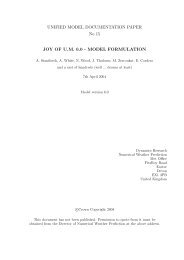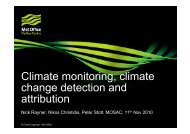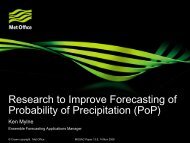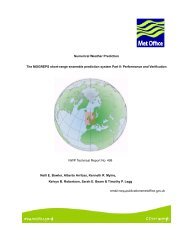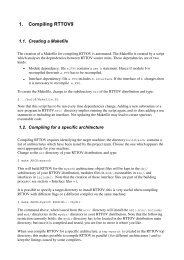1 BackgroundS<strong>in</strong>ce <strong>the</strong> implementation <strong>of</strong> <strong>the</strong> non-hydrostatic New Dynamical core <strong>of</strong> <strong>the</strong> Unified Model <strong>in</strong> 2002(Davies et al., 2005), all operational forecast models at <strong>the</strong> <strong>Met</strong> <strong>Office</strong> have used <strong>the</strong> same 38 levelvertical grid. This situation changed when <strong>in</strong> November 2005 <strong>the</strong> Global model <strong>in</strong>creased to 50 levelswhich provided <strong>in</strong>creased resolution (particularly <strong>in</strong> <strong>the</strong> stratosphere) and <strong>the</strong> model top was raised toallow assimilation <strong>of</strong> more satellite radiance observations. This change <strong>in</strong> setup meant that <strong>the</strong> globalmodel had to perform vertical <strong>in</strong>terpolation <strong>in</strong> order to provide lateral boundary conditions on <strong>the</strong> lowerresolution vertical grid <strong>in</strong> <strong>the</strong> limited area models (LAMs).Problems were immediately noticed when <strong>the</strong> run-time <strong>of</strong> <strong>the</strong> North Atlantic and European (NAE)model <strong>in</strong>creased by around 25%. This run-time <strong>in</strong>crease was found to result from an <strong>in</strong>creased iterationcount <strong>in</strong> <strong>the</strong> dynamics Helmholtz solver. The problem was temporarily resolved by impos<strong>in</strong>g hydrostaticbalance <strong>in</strong> <strong>the</strong> <strong>Exner</strong> <strong>pressure</strong> and resett<strong>in</strong>g density us<strong>in</strong>g <strong>the</strong> equation <strong>of</strong> state. While this helped toreduce <strong>the</strong> iteration count to with<strong>in</strong> operationally acceptable levels, an undesirable side effect was <strong>the</strong><strong>in</strong>troduction <strong>of</strong> a 2hPa negative bias <strong>in</strong> <strong>the</strong> <strong>pressure</strong> at mean sea level (PMSL), as shown <strong>in</strong> Figure 1.Figure 1: Example <strong>of</strong> onset <strong>of</strong> <strong>the</strong> PMSL bias <strong>in</strong> <strong>the</strong> NAE when impos<strong>in</strong>g hydrostatic balance <strong>in</strong> <strong>the</strong> boundaries.Difference <strong>in</strong> PMSL [Pa] (NAE - global model) is shown dur<strong>in</strong>g <strong>the</strong> first few hours <strong>of</strong> <strong>the</strong> forecast.Several years earlier, <strong>the</strong> development <strong>of</strong> <strong>the</strong> High Resolution Trial Model (HRTM) required avertical resolution <strong>in</strong>crease with<strong>in</strong> <strong>the</strong> high-resolution nested model. It was decided that short-rangeforecasts <strong>of</strong> fog and low-cloud would benefit most from hav<strong>in</strong>g more vertical levels <strong>in</strong> <strong>the</strong> troposphereand <strong>in</strong> particular near <strong>the</strong> surface. Therefore, a new vertical levels set was constructed with <strong>in</strong>creasedresolution near <strong>the</strong> surface, but lower resolution <strong>in</strong> <strong>the</strong> stratosphere where <strong>the</strong> impact was expectedto be negligible. This model was <strong>the</strong>n run us<strong>in</strong>g lateral boundary conditions (LBCs) provided by <strong>the</strong>standard 38 level mesoscale model. However, it was soon noticed that <strong>the</strong> PMSL <strong>in</strong> <strong>the</strong> 4km modelwas about 8hPa higher than <strong>in</strong> <strong>the</strong> 12km driv<strong>in</strong>g model. This large PMSL bias associated with <strong>the</strong> use<strong>of</strong> vertically <strong>in</strong>terpolated LBCs appears to vary with <strong>the</strong> particular configuration <strong>of</strong> vertical grids usedby <strong>the</strong> driv<strong>in</strong>g and driven models.These two problems (high solver iteration count and PMSL bias) have been found to be caused by<strong>the</strong> same process. When runn<strong>in</strong>g a LAM on a different vertical grid from that <strong>of</strong> <strong>the</strong> driv<strong>in</strong>g model,3
<strong>the</strong> LBC data must be <strong>in</strong>terpolated onto <strong>the</strong> required grid; this vertical <strong>in</strong>terpolation <strong>of</strong> model variablescan result <strong>in</strong> a new model state which is no longer dynamically <strong>balanced</strong>. Any imbalance generatedby <strong>the</strong> action <strong>of</strong> <strong>in</strong>terpolation manifests itself as vertical accelerations along <strong>the</strong> lateral boundaries.These strong vertical accelerations can cause a reduction <strong>in</strong> <strong>the</strong> surface <strong>pressure</strong> and an <strong>in</strong>crease <strong>in</strong> <strong>the</strong>number <strong>of</strong> iterations required for <strong>the</strong> Helmholtz dynamics solver to converge on a stable solution.While forecasts <strong>of</strong> <strong>the</strong> large scale flow out to one week (made by <strong>the</strong> global model) can be benefitedby <strong>the</strong> use <strong>of</strong> extra satellite observations <strong>in</strong> <strong>the</strong> stratosphere and mesosphere (Walters et al., 2007), aforecast <strong>of</strong> <strong>the</strong> formation <strong>of</strong> fog or low cloud (<strong>in</strong> convective-scale model) may benefit more by hav<strong>in</strong>gmore vertical levels with<strong>in</strong> <strong>the</strong> boundary layer (Tardif, 2004; Bechtold et al., 1996). Future <strong>Met</strong> <strong>Office</strong>NWP plans <strong>in</strong>volve runn<strong>in</strong>g operational forecast models on different vertical grids <strong>in</strong> order to maximise<strong>the</strong> performance <strong>of</strong> each model over <strong>the</strong>ir target time period. Consequently, a solution to <strong>the</strong> problemsdescribed earlier were required. This report describes <strong>the</strong> work related to identify<strong>in</strong>g <strong>the</strong> cause <strong>of</strong> <strong>the</strong>seproblems, <strong>the</strong> proposed solution, followed by a summary <strong>of</strong> forecast trials lead<strong>in</strong>g to its operationalimplementation <strong>in</strong> <strong>the</strong> NAE after Parallel Suite 14 (March 2007).2 Idealised experiments to identify <strong>the</strong> causes <strong>of</strong> <strong>the</strong> problemThe operational NAE and <strong>the</strong> operational global model differ considerably <strong>in</strong> <strong>the</strong>ir setup. Apart from<strong>the</strong> obvious difference <strong>in</strong> <strong>the</strong>ir horizontal resolutions, many <strong>of</strong> <strong>the</strong> options <strong>in</strong> <strong>the</strong> dynamical core andparameterisation <strong>of</strong> physical processes also differ, along with <strong>the</strong> choice <strong>of</strong> surface and climatologicalancillary files, data assimilation systems and observations used. In a bid to isolate <strong>the</strong> factors caus<strong>in</strong>gthis problem, a highly idealised approach was adopted. The aim <strong>of</strong> this experiment was to reproduce<strong>the</strong> negative PMSL bias found when runn<strong>in</strong>g a limited area model on a different vertical grid from that<strong>of</strong> <strong>the</strong> global model and impos<strong>in</strong>g hydrostatic balance <strong>in</strong> <strong>the</strong> LBCs.2.1 Model setupAn idealised configuration <strong>of</strong> <strong>the</strong> Unified Model was used which shared <strong>the</strong> same dynamical core as <strong>the</strong>operational models, did not <strong>in</strong>clude parameterisation <strong>of</strong> sub-grid processes or moisture and ran fromidealised <strong>in</strong>itial conditions.To mimic <strong>the</strong> operational setup, an idealised global model was used to drive an idealised limitedarea model which ran on a different vertical grid. To isolate <strong>the</strong> action <strong>of</strong> vertical <strong>in</strong>terpolation <strong>in</strong> <strong>the</strong>generation <strong>of</strong> <strong>the</strong> LBCs as far as possible, <strong>the</strong> idealised LAM used exactly <strong>the</strong> same horizontal grid asthat <strong>of</strong> <strong>the</strong> idealised global model, i.e. <strong>the</strong> LAM had <strong>the</strong> same grid length and did not use a rotatedpole, such that grid po<strong>in</strong>ts <strong>in</strong> <strong>the</strong> LAM were simply a subset <strong>of</strong> those <strong>in</strong> <strong>the</strong> global model. A horizontalgrid spac<strong>in</strong>g <strong>of</strong> 0.833x0.554 degrees (N216 equivalent) was used <strong>in</strong> both models which resulted <strong>in</strong>432x325 grid po<strong>in</strong>ts <strong>in</strong> <strong>the</strong> global model and a 150x150 subset <strong>of</strong> <strong>the</strong>se, centred about <strong>the</strong> equator, <strong>in</strong><strong>the</strong> LAM (see Figure 2).A timestep <strong>of</strong> 20 m<strong>in</strong>utes was found to give numerically stable results and so no horizontal or verticaldiffusion was needed <strong>in</strong> <strong>the</strong>se idealised simulations. LBCs were updated every timestep so that anyeffects from a low update frequency <strong>in</strong> <strong>the</strong> LBCs was avoided. In every respect, o<strong>the</strong>r than <strong>the</strong> use <strong>of</strong>LBCs and a different vertical grid <strong>in</strong> <strong>the</strong> LAM, <strong>the</strong> setup <strong>of</strong> both model was identical. An aqua-planetsphere was adopted to remove <strong>the</strong> complications <strong>in</strong>troduced by <strong>the</strong> land surface and orography.The global model used 50 vertical levels where <strong>the</strong> thickness <strong>in</strong>creased quadratically with height(similar to <strong>in</strong> <strong>the</strong> operational models), whereas <strong>the</strong> limited area model used a 38 level equivalent (seeFigure 3). The eta levels used <strong>in</strong> <strong>the</strong>se idealised models were <strong>the</strong> same as those <strong>of</strong> <strong>the</strong> operational4




